Abstract
For certain cell types, the cross-linking of bivalent cell surface receptors by multivalent ligands is an important biochemical step in the transmission of information across the cell's membrane to its interior. The formation of cell surface receptor-ligand aggregates has been shown to "turn on" and "turn off" particular cell responses. It has been hypothesized that very large aggregates generate signals that small aggregates cannot. This hypothesis has not been rigorously tested as yet, in part because of a lack of quantitative information about aggregate sizes. Here we develop a general equilibrium theory for the clustering of bivalent receptors by trivalent ligands. In addition to predicting the concentrations of receptor-ligand aggregates of all possible sizes, we show that a range of ligand concentrations exists at which extremely large aggregates, i.e., superaggregates, form on the cell surface. The formation of a superaggregate corresponds to a sol-gel phase transition, and we study this transition in some detail. For the biologically interesting case of histamine release by basophils, we show, using realistic parameter values, that such transitions should occur when the cells are from highly allergic individuals. We prescribe in detail experimental conditions under which such transitions should occur. These conditions can be used as a guide to test whether or not large aggregates provide signals to cells that small aggregates do not.
Full text
PDF
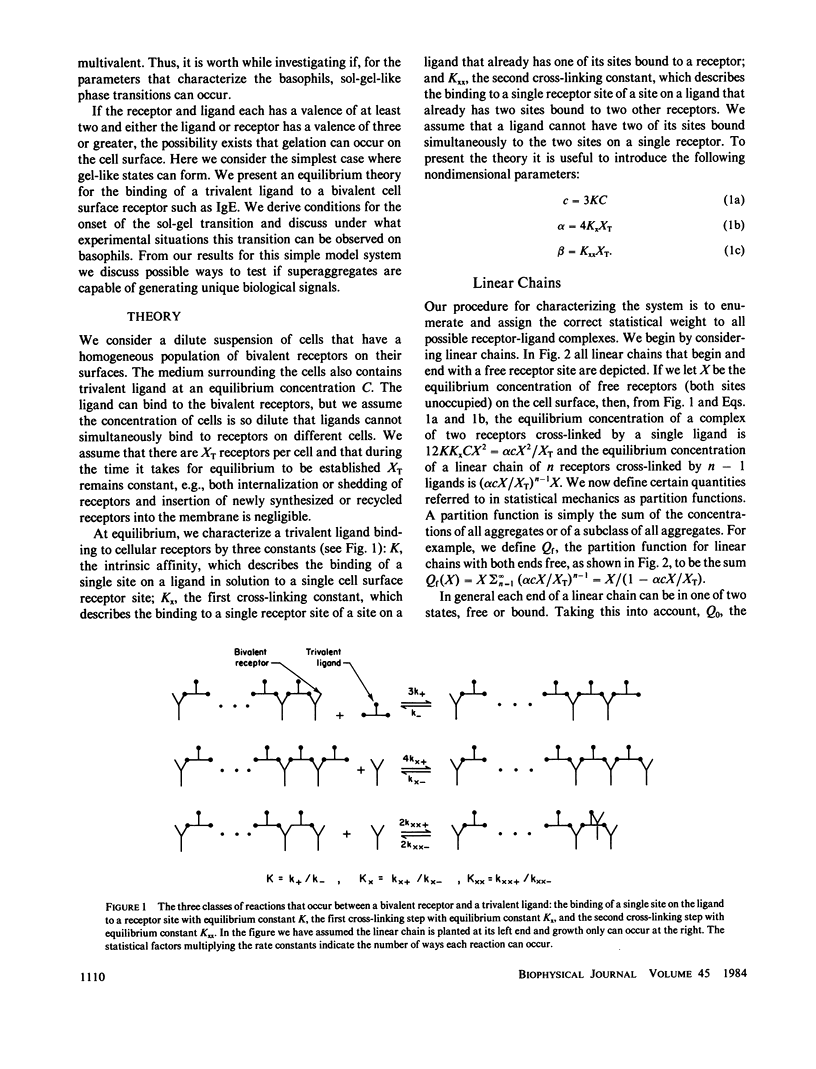
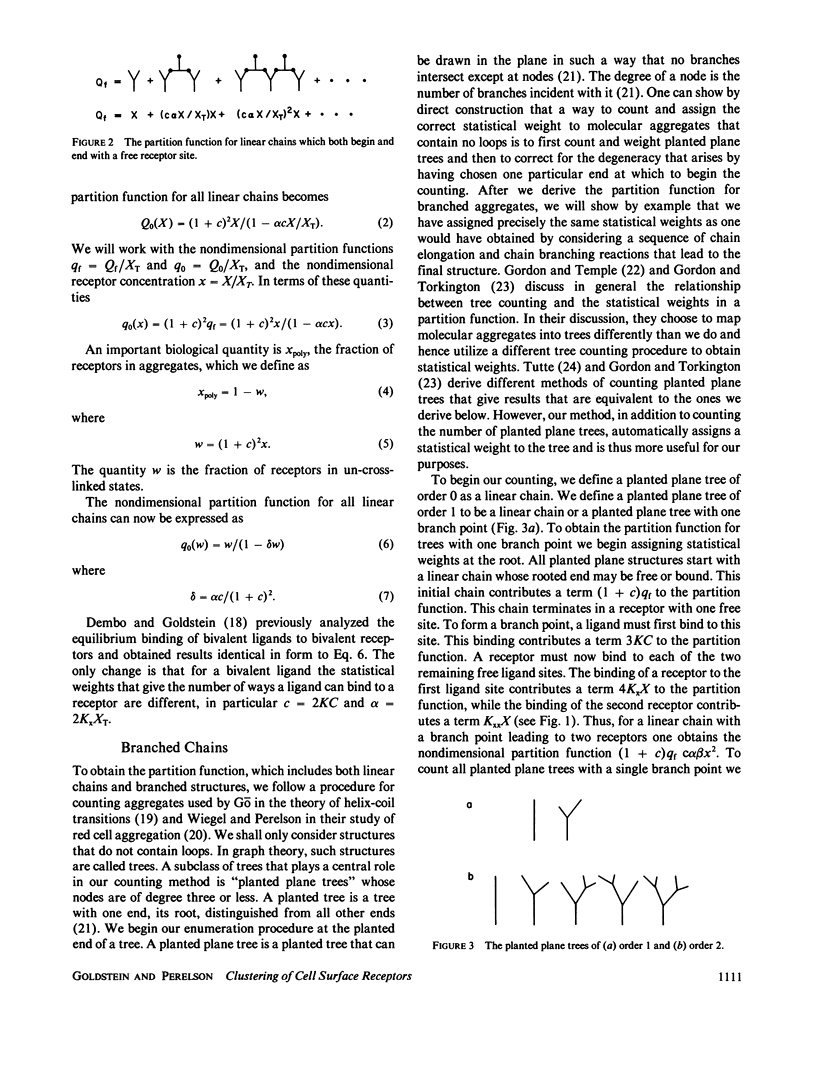

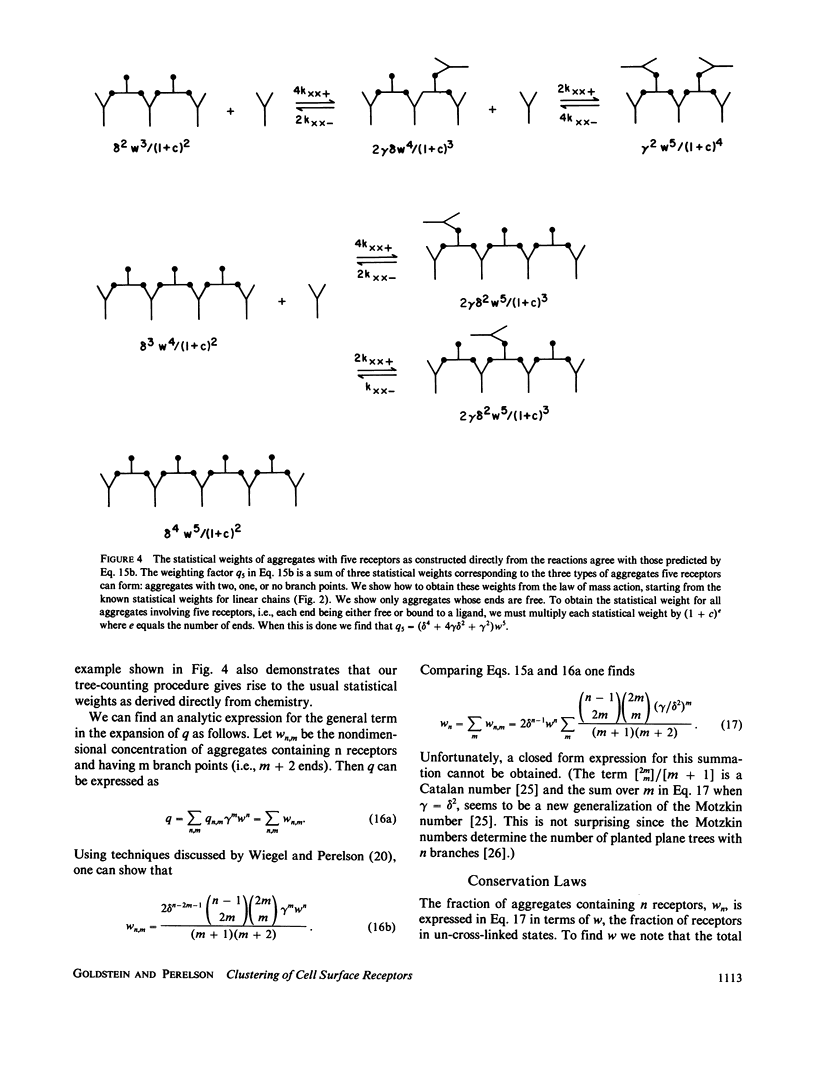




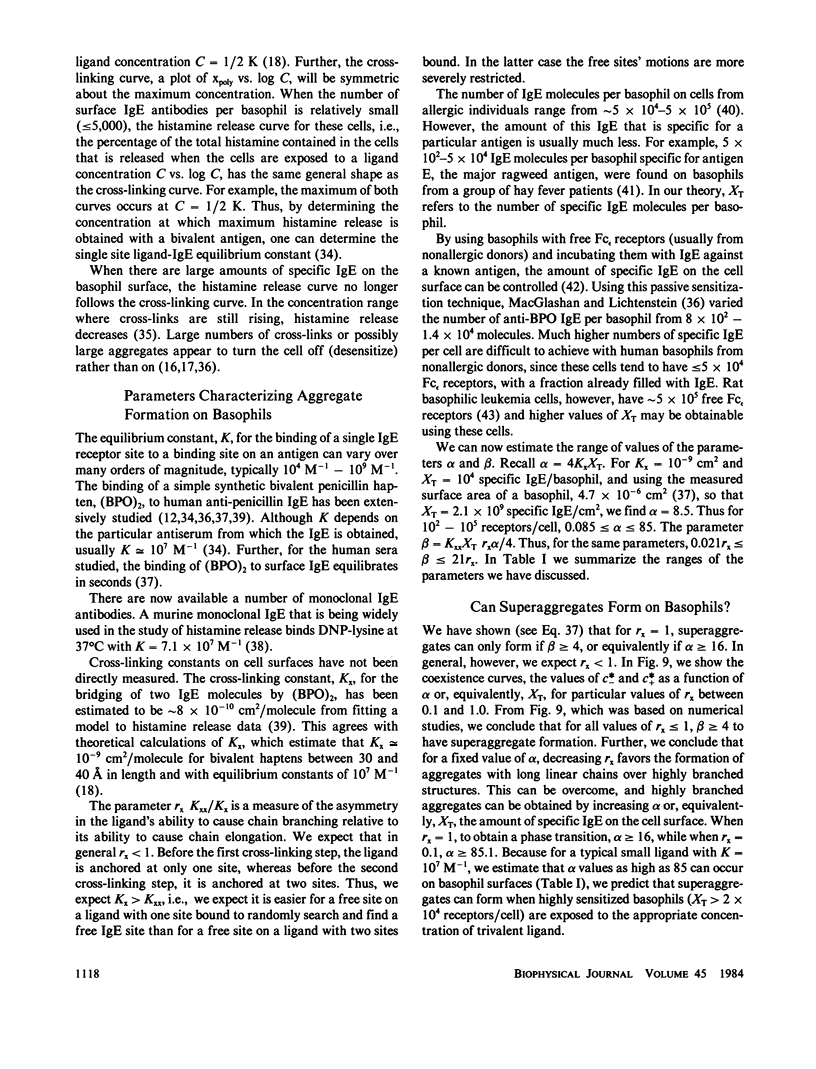
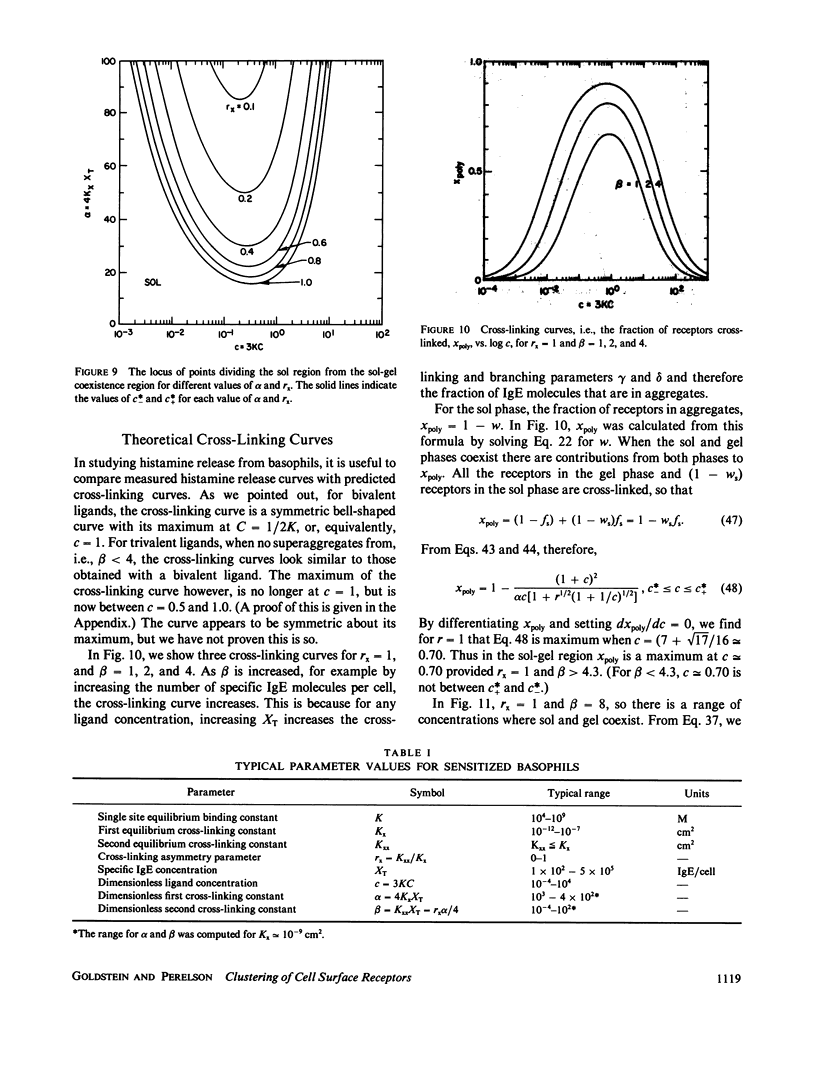




Selected References
These references are in PubMed. This may not be the complete list of references from this article.
- Barsumian E. L., Isersky C., Petrino M. G., Siraganian R. P. IgE-induced histamine release from rat basophilic leukemia cell lines: isolation of releasing and nonreleasing clones. Eur J Immunol. 1981 Apr;11(4):317–323. doi: 10.1002/eji.1830110410. [DOI] [PubMed] [Google Scholar]
- Becker K. E., Ishizaka T., Metzger H., Ishizaka K., Grimley P. M. Surface IgE on human basophils during histamine release. J Exp Med. 1973 Aug 1;138(2):394–409. doi: 10.1084/jem.138.2.394. [DOI] [PMC free article] [PubMed] [Google Scholar]
- Becker K. E., Ishizaka T., Metzger H., Ishizaka K., Grimley P. M. Surface IgE on human basophils during histamine release. J Exp Med. 1973 Aug 1;138(2):394–409. doi: 10.1084/jem.138.2.394. [DOI] [PMC free article] [PubMed] [Google Scholar]
- Blum J. J., Conn P. M. Gonadotropin-releasing hormone stimulation of luteinizing hormone release: A ligand-receptor-effector model. Proc Natl Acad Sci U S A. 1982 Dec;79(23):7307–7311. doi: 10.1073/pnas.79.23.7307. [DOI] [PMC free article] [PubMed] [Google Scholar]
- Conn P. M., Rogers D. C., McNeil R. Potency enhancement of a GnRH agonist: GnRH-receptor microaggregation stimulates gonadotropin release. Endocrinology. 1982 Jul;111(1):335–337. doi: 10.1210/endo-111-1-335. [DOI] [PubMed] [Google Scholar]
- Conroy M. C., Adkinson N. F., Jr, lichtenstein L. M. Measurement of IgE on human basophils: relation to serum IgE and anti-IgE-induced histamine release. J Immunol. 1977 Apr;118(4):1317–1321. [PubMed] [Google Scholar]
- Delisi C., Siraganian R. P. Receptor cross-linking and histamine release. II. Interpretation and analysis of anomalous dose response patterns. J Immunol. 1979 Jun;122(6):2293–2299. [PubMed] [Google Scholar]
- Dembo M., Goldstein B., Sobotka A. K., Lichtenstein L. M. Degranulation of human basophils: quantitative analysis of histamine release and desensitization, due to a bivalent penicilloyl hapten. J Immunol. 1979 Oct;123(4):1864–1872. [PubMed] [Google Scholar]
- Dembo M., Goldstein B., Sobotka A. K., Lichtenstein L. M. Histamine release due to bivalent penicilloyl haptens the relation of activation and desensitization of basophils to dynamic aspects of ligand binding to cell surface antibody. J Immunol. 1979 Feb;122(2):518–528. [PubMed] [Google Scholar]
- Dembo M., Goldstein B., Sobotka A. K., Lichtenstein L. M. Histamine release due to bivalent penicilloyl haptens: control by the basophil plasma membrane. J Immunol. 1978 Jul;121(1):354–358. [PubMed] [Google Scholar]
- Dembo M., Goldstein B. Theory of equilibrium binding of symmetric bivalent haptens to cell surface antibody: application to histamine release from basophils. J Immunol. 1978 Jul;121(1):345–353. [PubMed] [Google Scholar]
- Fewtrell C., Metzger H. Larger oligomers of IgE are more effective than dimers in stimulating rat basophilic leukemia cells. J Immunol. 1980 Aug;125(2):701–710. [PubMed] [Google Scholar]
- Goldstein B., Dembo M., Malveaux F. J. Some quantitative aspects of the passive sensitization of human basophils. J Immunol. 1979 Mar;122(3):830–833. [PubMed] [Google Scholar]
- Isersky C., Taurog J. D., Poy G., Metzger H. Triggering of cultured neoplastic mast cells by antibodies to the receptor for IgE. J Immunol. 1978 Aug;121(2):549–558. [PubMed] [Google Scholar]
- Ishizaka T., Ishizaka K., Johansson S. G., Bennich H. Histamine release from human leukocytes by anti-gamma E antibodies. J Immunol. 1969 Apr;102(4):884–892. [PubMed] [Google Scholar]
- Ishizaka T., Ishizaka K. Triggering of histamine release from rat mast cells by divalent antibodies against IgE-receptors. J Immunol. 1978 Mar;120(3):800–805. [PubMed] [Google Scholar]
- Jacobs S., Chang K. J., Cuatrecasas P. Antibodies to purified insulin receptor have insulin-like activity. Science. 1978 Jun 16;200(4347):1283–1284. doi: 10.1126/science.663609. [DOI] [PubMed] [Google Scholar]
- Kagey-Sobotka A., Dembo M., Goldstein B., Metzger H., Lichtenstein L. M. Qualitative characteristics of histamine release from human basophils by covalently cross-linked IgE. J Immunol. 1981 Dec;127(6):2285–2291. [PubMed] [Google Scholar]
- Kulczycki A., Jr, Metzger H. The interaction of IgE with rat basophilic leukemia cells. II. Quantitative aspects of the binding reaction. J Exp Med. 1974 Dec 1;140(6):1676–1695. doi: 10.1084/jem.140.6.1676. [DOI] [PMC free article] [PubMed] [Google Scholar]
- Levy D. A., Osler A. G. Studies on the mechanisms of hypersensitivity phenomena. XIV. Passive sensitization in vitro of human leukocytes to ragweed pollen antigen. J Immunol. 1966 Aug;97(2):203–212. [PubMed] [Google Scholar]
- Lichtenstein L. M. The immediate allergic response: in vitro separation of antigen activation, decay and histamine release. J Immunol. 1971 Oct;107(4):1122–1130. [PubMed] [Google Scholar]
- Liu F. T., Bohn J. W., Ferry E. L., Yamamoto H., Molinaro C. A., Sherman L. A., Klinman N. R., Katz D. H. Monoclonal dinitrophenyl-specific murine IgE antibody: preparation, isolation, and characterization. J Immunol. 1980 Jun;124(6):2728–2737. [PubMed] [Google Scholar]
- MacGlashan D. W., Jr, Lichtenstein L. M. The transition from specific to nonspecific desensitization in human basophils. J Immunol. 1981 Dec;127(6):2410–2414. [PubMed] [Google Scholar]
- MacGlashan D. W., Jr, Schleimer R. P., Lichtenstein L. M. Qualitative differences between dimeric and trimeric stimulation of human basophils. J Immunol. 1983 Jan;130(1):4–6. [PubMed] [Google Scholar]
- MacGlashan D., Jr, Lichtenstein L. M. Studies of antigen binding on human basophils. I. Antigen binding and functional consequences. J Immunol. 1983 May;130(5):2330–2336. [PubMed] [Google Scholar]
- MacGlashan D., Jr, Mogowski M., Lichtenstein L. M. Studies of antigen binding on human basophils. II. Continued expression of antigen-specific IgE during antigen-induced desensitization. J Immunol. 1983 May;130(5):2337–2342. [PubMed] [Google Scholar]
- Macken C. A., Perelson A. S. Aggregation of cell surface receptors by multivalent ligands. J Math Biol. 1982;14(3):365–370. doi: 10.1007/BF00275399. [DOI] [PubMed] [Google Scholar]
- Peacock J. S., Barisas B. G. Photobleaching recovery studies of T-independent antigen mobility on antibody-bearing liposomes. J Immunol. 1983 Dec;131(6):2924–2929. [PubMed] [Google Scholar]
- Schreiber A. B., Lax I., Yarden Y., Eshhar Z., Schlessinger J. Monoclonal antibodies against receptor for epidermal growth factor induce early and delayed effects of epidermal growth factor. Proc Natl Acad Sci U S A. 1981 Dec;78(12):7535–7539. doi: 10.1073/pnas.78.12.7535. [DOI] [PMC free article] [PubMed] [Google Scholar]
- Schreiber A. B., Libermann T. A., Lax I., Yarden Y., Schlessinger J. Biological role of epidermal growth factor-receptor clustering. Investigation with monoclonal anti-receptor antibodies. J Biol Chem. 1983 Jan 25;258(2):846–853. [PubMed] [Google Scholar]
- Segal D. M., Taurog J. D., Metzger H. Dimeric immunoglobulin E serves as a unit signal for mast cell degranulation. Proc Natl Acad Sci U S A. 1977 Jul;74(7):2993–2997. doi: 10.1073/pnas.74.7.2993. [DOI] [PMC free article] [PubMed] [Google Scholar]
- Sobotka A. K., Dembo M., Goldstein B., Lichtenstein L. M. Antigen-specific desensitization of human basophils. J Immunol. 1979 Feb;122(2):511–517. [PubMed] [Google Scholar]
- Van Obberghen E., Spooner P. M., Kahn C. R., Chernick S. S., Garrison M. M., Karlsson F. A., Grunfeld C. Insulin-receptor antibodies mimic a late insulin effect. Nature. 1979 Aug 9;280(5722):500–502. doi: 10.1038/280500a0. [DOI] [PubMed] [Google Scholar]
- Zeiss C. R., Pruzansky J. J., Levitz D., Wang J. The quantification of IgE antibody specific for ragweed Antigen E (AgE) on the basophil surface in patients with ragweed pollenosis. Immunology. 1978 Aug;35(2):237–246. [PMC free article] [PubMed] [Google Scholar]


